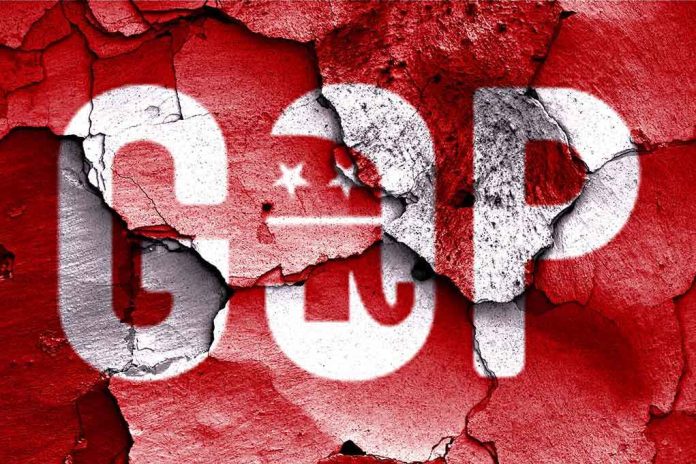
Republican infighting following the 2024 electoral “bloodbath” threatens conservative values and exposes urgent questions about the party’s future under President Trump.
Story Snapshot
- The 2024 elections saw Republicans lose ground in key races, defying expectations and triggering deep internal party debates.
- Despite setbacks, President Trump quickly moved to restore conservative priorities, signing landmark legislation and reversing leftist policies.
- GOP leadership changes and factional disputes dominate the post-election landscape, with calls for unity and recalibration.
- Democrats gained momentum in battlegrounds, forcing Republicans to rethink strategy and messaging for 2025 and beyond.
Republican Losses Spark Immediate Leadership Shakeup
On November 5, 2024, Republicans faced unexpectedly severe losses in high-profile races, shaking confidence even within districts long considered safe. Analysts reported that the scale of defeat surpassed 2018’s “Blue Wave” and sent shockwaves through the party’s base. By November 13, final election calls confirmed Democrats had secured victories in crucial battlegrounds, compelling GOP leaders to convene urgent strategy sessions. Voters, especially suburban and independent groups, shifted away from Republican candidates, citing frustrations over internal divisions and messaging failures.
Leadership contests unfolded as Republicans retained formal control of Congress but faced a clear crisis of legitimacy. John Thune was elected Senate Majority Leader, while Mike Johnson was set to remain House Speaker. However, these appointments did not close rifts between establishment figures and populist factions. The Republican National Committee and key Congressional chairs such as Jim Jordan and James Comer began public and internal talks about recalibrating the party’s direction. Party leaders acknowledged the need for a “well-designed playbook,” though questions linger about policy priorities and unity moving into 2025.
Trump Administration Delivers Rapid Conservative Victories Amid Backlash
In response to conservative frustrations over past leftist policies, President Trump launched a series of decisive actions in his first six months back in office. He signed over 170 executive orders, targeting issues like border security, government overreach, and radical indoctrination in schools. Notably, the administration closed the border, protected benefit programs for U.S. citizens, and ended taxpayer subsidization of illegal immigration. The Supreme Court consistently backed Trump’s agenda, permitting “third-country deportations” and approving the revocation of temporary protected status for over 500,000 migrants. These moves directly addressed concerns about constitutional erosion, illegal immigration, and fiscal mismanagement that angered conservatives under previous leadership.
President Trump’s achievements extended overseas, securing NATO agreements to raise defense spending and inking trade deals with major partners. The administration delivered the first June Treasury surplus since 2005 and drove record-high market indices. Domestically, blue-collar wage growth surged, and law and order was restored, with the country on track for its lowest murder rate ever. In education and health, Trump ended radical DEI programs, stopped “gender-affirming care” for minors, and removed men from women’s sports, reinforcing family values and safeguarding children from ideological overreach.
GOP Internal Strife Threatens Conservative Messaging and 2026 Prospects
While President Trump’s victories energize the conservative base, the Republican Party’s internal divisions remain a significant obstacle. Factional disputes between establishment and populist groups have led to leadership challenges and caution on repealing certain Democratic policies. Some Republicans urge restraint, especially regarding the Inflation Reduction Act, reflecting broader uncertainty about the legislative agenda. Analysts argue that the party’s focus on culture war issues may have alienated moderates, while others blame candidate quality and campaign missteps for the losses. Expert opinions highlight demographic shifts, particularly among suburban women and young voters, as critical factors in the GOP’s defeat. The party faces pressure to adapt its platform and messaging to prevent further erosion ahead of the 2026 midterms.
Tuesday Was a Bloodbath for Republicans, So What Now? https://t.co/qc9bOiDQWW
— Joni Myers (@JoniMyers18) November 5, 2025
Industry and advocacy groups are recalibrating strategies as regulatory priorities shift under new committee leadership. Uncertainty surrounds sectors dependent on federal policy, such as energy and healthcare. Political gridlock is possible if party divisions persist, potentially hampering conservative legislative goals. Cross-referenced data from credible sources confirms leadership changes and validates the immediate and long-term implications of the 2024 bloodbath for Republicans. Despite legislative wins under Trump, the GOP must unify to effectively defend constitutional principles, gun rights, and family values against ongoing attacks from leftist agendas.
Sources:
Balance of Power in the U.S. House and Senate – APM Research Lab
Balance of Power in the U.S. House and Senate – Bloomberg Government
Republicans Pick New Leaders as 2025 Plans Come Into Focus – E&E News
Leadership Changes: What to Watch Going Into 2025 – NCSL





